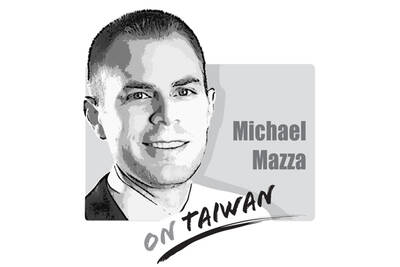Double Ten National Day is the time of year when the ideologies of President Tsai Ing-wen (蔡英文) and her Democratic Progressive Party (DPP) are most rigorously scrutinized by the opposition, and this year was no exception.
People with a Taiwan-centric view already find it hard to stomach that the nation is still celebrating the founding of a regime that should have ceased to exist after the Chinese Nationalist Party (KMT) lost the Chinese Civil War.
Unfortunately for the president, the Constitution still says that Taiwan is China. The Republic of China (ROC) system is baggage that she cannot shake off, regardless of how much she would like to normalize the nation’s status and call it by its real name, Taiwan.
In the first two years of her presidency, Tsai attempted to phase out the use of ROC symbols, including the title, national flag and national emblem, especially for National Day celebrations.
Her administration has also tried to add more politically neutral colors and lively elements to national day designs in an apparent effort to distance itself from the usual ROC colors of red and blue, and designs characteristic of traditional Chinese culture.
As expected, such attempts sparked a backlash among ROC patriots and the system’s biggest defender, the KMT, which fiercely accused the DPP administration of trying to “de-ROC-ize” Taiwan.
Surpsisingly, the Tsai administration has succumbed to such criticism and compromised, where it should have held its ground to address the nation’s struggle with its identity.
This year, the ROC flag reappeared in the government’s main National Day designs. In a perceived attempt to please both sides, the administration also covered a ceremonial arch at the intersection of Taipei’s Ketagalan Boulevard and Gongyuan Road with LED panels that displayed this year’s main National Day design theme and a more traditional theme.
However, the administration failed to realize that by trying to please everyone, it might end up pleasing no one — especially when the opposition is merely seeking to obstruct.
Does the KMT care about the ROC system? Most likely yes. However, it has lately been using the ROC as a weapon to drive a wedge between the DPP and voters who harbor nostalgia for the ROC.
If forcing the Tsai administration to concede on the ROC issue was the KMT’s goal, the party would have withdrawn its criticism and instead appreciated the uneasy balance that the government tried to strike, which could cost the DPP support from the pro-independence camp. Instead, the KMT went forward with its alternative celebration that emphasized ROC patriotism.
The party justified holding its event by saying that the ROC flags printed on this year’s National Day merchandize were “too small.”
Just as no amount of goodwill from the Tsai administration will change Beijing’s mind about the DPP being independence-leaning, no concessions by the DPP administration will ever be enough to convince the KMT that the Tsai government is willing to embrace the ROC system and “one China” idea that it supports. So why even try?
The government should focus on the goals it set forth two years ago and not let criticism cause it to lose sight of the bigger picture — especially criticism from its political opponents, which is only designed to stir up negative emotions.
The image was oddly quiet. No speeches, no flags, no dramatic announcements — just a Chinese cargo ship cutting through arctic ice and arriving in Britain in October. The Istanbul Bridge completed a journey that once existed only in theory, shaving weeks off traditional shipping routes. On paper, it was a story about efficiency. In strategic terms, it was about timing. Much like politics, arriving early matters. Especially when the route, the rules and the traffic are still undefined. For years, global politics has trained us to watch the loud moments: warships in the Taiwan Strait, sanctions announced at news conferences, leaders trading
The saga of Sarah Dzafce, the disgraced former Miss Finland, is far more significant than a mere beauty pageant controversy. It serves as a potent and painful contemporary lesson in global cultural ethics and the absolute necessity of racial respect. Her public career was instantly pulverized not by a lapse in judgement, but by a deliberate act of racial hostility, the flames of which swiftly encircled the globe. The offensive action was simple, yet profoundly provocative: a 15-second video in which Dzafce performed the infamous “slanted eyes” gesture — a crude, historically loaded caricature of East Asian features used in Western

Is a new foreign partner for Taiwan emerging in the Middle East? Last week, Taiwanese media reported that Deputy Minister of Foreign Affairs Francois Wu (吳志中) secretly visited Israel, a country with whom Taiwan has long shared unofficial relations but which has approached those relations cautiously. In the wake of China’s implicit but clear support for Hamas and Iran in the wake of the October 2023 assault on Israel, Jerusalem’s calculus may be changing. Both small countries facing literal existential threats, Israel and Taiwan have much to gain from closer ties. In his recent op-ed for the Washington Post, President William
A stabbing attack inside and near two busy Taipei MRT stations on Friday evening shocked the nation and made headlines in many foreign and local news media, as such indiscriminate attacks are rare in Taiwan. Four people died, including the 27-year-old suspect, and 11 people sustained injuries. At Taipei Main Station, the suspect threw smoke grenades near two exits and fatally stabbed one person who tried to stop him. He later made his way to Eslite Spectrum Nanxi department store near Zhongshan MRT Station, where he threw more smoke grenades and fatally stabbed a person on a scooter by the roadside.